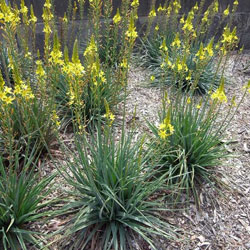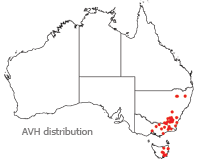Bulbine glauca
|
 |
Rock Lily
Bulbine glauca (Raf.) E.M.Watson
Bulbine glauca is in the family Asphodelaceae (although it is sometimes placed in the Liliaceae) and is commonly known as Rock lily. The genus Bulbine comprises of about 50 species, most of which are native to Southern or Eastern Africa, with only 5 species native to Australia.
Bulbine glauca is a tufted perennial that grows to a height of about 50cm, with thick and fleshy roots. The flowers are borne on spikes, knows as inflorescences, which in the wild usually develop after rain. The plant produces two or more inflorescences, with small, yellow, star-shaped flowers, which are faintly scented. The flowers can begin to open in spring and sometimes continue right through to autumn if the weather conditions are right and the plant receives regular water throughout the hot months.
Each plant has about 6 to 16 leaves, which are erect and taper to a cylindrical point at the apex. The leaves are glaucous, which is from the Latin word glauca, meaning bluish-grey, relating to the leaf colour.
Bulbine glauca is distinguished from Bulbine bulbosa, by the absence of a tuber and the anthers are not obscured by hairs.
 The distribution of Bulbine glauca is in New South Wales, Victoria, Tasmania and possibly into Queensland. Its distribution is mostly associated with elevated areas, cliffs, crevices and summits, and along the Great Diving Range in Victoria and New South Wales.
The distribution of Bulbine glauca is in New South Wales, Victoria, Tasmania and possibly into Queensland. Its distribution is mostly associated with elevated areas, cliffs, crevices and summits, and along the Great Diving Range in Victoria and New South Wales.
Bulbine glauca is easy to propagate in rich, well-drained soil in an area that is regularly watered, through either self-seeding or dividing older plants. The seedlings that come up in spring are able to be transplanted, and will still flower that summer. Seedlings do not tend to come up in the areas that are not regularly watered, so there is very little chance of it becoming weedy.
During the hot months, watering 2 to 3 times a week is required, but allowed to dry off after.
Mature plants are occasionally susceptible to rot of the roots, but this only affects one plant and doe not spread, so the affected plant can be removed. Bulbine glauca is also susceptible to slugs, snails and kangaroos.
Bulbine glauca is horticulturally desirable as it is frost tolerant, with the leaves persistent throughout winter. It is able to be grown in full sun to light shade and prefers a slightly protected area. It has a long flowering time, and the only maintenance that is required is removing the spikes after flowering. A general liquid fertilizer once a month is not essential but will help the plant look its best.
Text by Erin Batty (2008 Student Botanical Intern)
Name Meaning: Bulbine glaucaBulbine – Latin word which means a bulb, although only a few species in the genus actually grow from a bulb. glauca – Latin word meaning bluish-grey, relating to the leaf colour |
References
Clifford, H.T., Conran, J.G. and Thongpukdee, A. (1992) Australian Lilies: Native and Naturalised Species. Australian Plants 16(132).
Corrick, M.G. and Fuhrer, B.A. (2000) Wildflowers of Victoria. Bloomings Books
Dahlgren, R.M.T., Clifford, H.T, and Yeo, P.F. (1985) The Families of the Monocotyledons. Structure Evolution and Taxonomy. Springer-Verlag Berlin.
Gardening Australia (2003) Flora: The Gardener’s Bible. ABC Books.
Hurle, P. (2008) Horticulture Manager, Australian National Botanic Gardens. Personal communication.
Marchant J. R.V. and Charles J.F. (1946) Cassell’s Latin Dictionary: Twenty Fourth Edition. Cassell and Company.
Page, S. and Olds, M. (eds) (1997) Botanica: The Illustrated A-Z of over 10,000 Garden Plants for Australian Gardens and How to Cultivate Them. Random House Australia.
Walsh, N.G. and Entwisle, T.J. (eds) (1994) Flora of Victoria.Volume 2: Ferns and Allied plants, Conifers and Monocotyledons. Inkata Press, Melbourne.
Watson, E.M. (1987) Bulbine in George, A.S. (ed) Flora of Australia. Volume 45: Hydatellaceae to Liliaceae. Australian Government Publishing Service, Canberra.
![An Australian Government Initiative [logo]](/images/austgovt_brown_90px.gif)



